GENERAL DENTISTRY
“WE PROVIDE PAINLESS DENTISTRY”
Get in touch with us today!
It encompasses both white as well as pink aesthetics. Thus it is essential that there is harmony between the teeth and the surrounding gums. This speciality dentist leaves no stone unturned to give a beautiful and healthy smile to the people. They are..
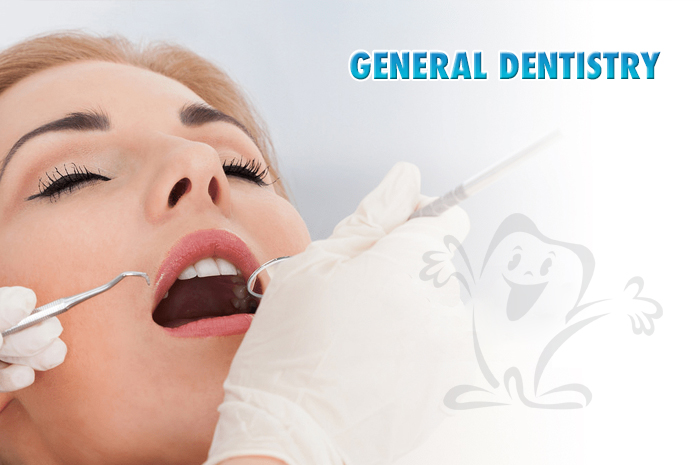
A) Oral Prophylaxis
The mouth has to bear the brunt of a lot of fluids and food that we consume. The teeth are aligned in such a way that the interdental spaces between teeth are difficult to clean. The brush cannot reach such areas and slowly plaque starts forming on the teeth. Plaque is a soft, yellowish, sticky film comprising of microorganisms and food debris that forms on the tooth surface. The bacteria in plaque multiply and cause infection of the gums leading to swollen and bleeding gums. If plaque is not removed then it mineralizes to form calculus or tartar that cannot be removed from the tooth. This tartar can serve as a niche for cavity formation. Certain beverages that we consume also stain the teeth giving a very unpleasant colour to the teeth reducing the self confidence of the patient. This plaque or tartar has to be removed with the help of a dentist. It can be visible by using plaque detection dyes.
To maintain teeth in the oral cavity for a long time, it is mandatory to keep the gums and teeth in healthy condition. Scaling can restore the health of gums by removing plaque, calculus/tartar and stains from the tooth surface.
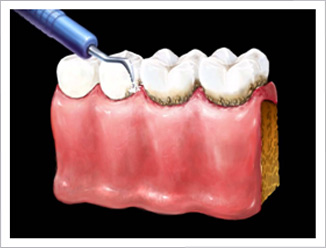
This process is performed by a trained dentist. They use ultrasonic instruments called scalers to remove plaque from unreachable areas above and below the tooth into the sulcus. Scaling is performed by vibrations which loosen the plaque and calculus and remove it. As the vibrations are very delicate, they do not harm the tooth surface. Once the procedure is performed polishing of the teeth is done where an abrasive paste is used to clean small irregularities and stains from the teeth. Generally it takes 30-40 minutes to finish the procedure. Our team is highly skilled in performing this most important procedure in the field of dentistry to keep your mouth disease free at any point of time.
Scaling prevents tooth decay, gum diseases that cause loosening of teeth, bad breath, removes stains and can prove to be cheap in a long run as it reduces the risk of all the harmful effects that plaque can cause.
Scaling is performed by delicate vibrations which do not harm the teeth. Normally it should be performed twice a year. But, in patients with severe gum diseases or undergoing orthodontic treatment it should be carried out every 3-4 months. This is the best way to maintain overall health as mouth is the window of many systemic diseases. Thus a healthy mouth can be a backbone of a healthy body.
B) Simple tooth Extractions
The process of removing the tooth from its socket is called tooth extraction. The panel of dentists in our clinic first try to retain the tooth. When all possible ways fail after that only the tooth is extracted.
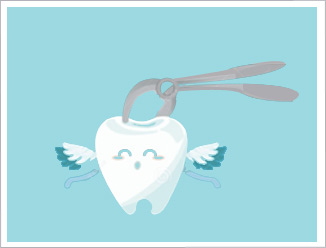
Extraction is carried out for teeth beyond repair i.e. in which root canal treatment cannot be performed, which is badly positioned, extensively broken or very mobile. Other ideal candidates for removal are orthodontic treatment patients in whom removal is deemed necessary.
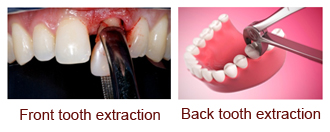
Most people have phobia regarding tooth removal. At V4U Dental Care we provide a very comfortable environment and follow a stress free protocol for extraction. It is carried out for teeth that are visible in the oral cavity only. Firstly a local anaesthetic solution is injected in the area where the tooth is to be removed. After the surrounding area gets numb, the gums are detached from the tooth by a hand instrument called gum separator/periosteal elevator. After the gums are separated the tooth is loosened a little from its socket by the use of tooth elevators using rhythmic wriggling movements. Once the tooth is loose in its socket, it is removed with the help of tooth forceps. After the tooth is removed, the area is irrigated with saline and scrapped with a spoon excavator to remove all diseased tissue. After this, slight pressure is applied to stop the bleeding with the help of cotton/gauze piece. A small piece of cotton is placed at the site and the patient is asked to bite on it for half an hour.
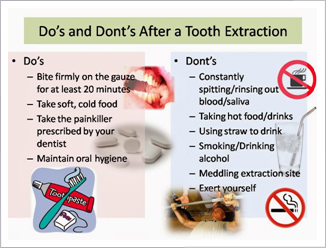 After the completion of the procedure the patient is told to wait for approx. 15 minutes and later checked whether bleeding has stopped. The patient is instructed to remove the piece of cotton after about half an hour. Incase of infections antibiotics and painkillers are prescribed for 5 days. Patient is informed that the effect of anaesthesia will last for atleast 1 hour and till then do not drink or eat hot food as you can burn yourself. Do not bite the tongue, lips or cheeks. They are advised to refrain from eating spicy, hard or oily foods for 2-3 days and should eat on the other side of the mouth and not from the side tooth is removed. The patient is told to swallow all blood, saliva on the day of the procedure and not to spit. Incase of liquid consumption they should not use a straw but drink directly from the glass/bottle. They should refrain from smoking for a day atleast as all procedures that create negative pressure stimulate more bleeding. All these instructions HAVE to be FOLLOWED by the patient for fast and uneventful healing.
After the completion of the procedure the patient is told to wait for approx. 15 minutes and later checked whether bleeding has stopped. The patient is instructed to remove the piece of cotton after about half an hour. Incase of infections antibiotics and painkillers are prescribed for 5 days. Patient is informed that the effect of anaesthesia will last for atleast 1 hour and till then do not drink or eat hot food as you can burn yourself. Do not bite the tongue, lips or cheeks. They are advised to refrain from eating spicy, hard or oily foods for 2-3 days and should eat on the other side of the mouth and not from the side tooth is removed. The patient is told to swallow all blood, saliva on the day of the procedure and not to spit. Incase of liquid consumption they should not use a straw but drink directly from the glass/bottle. They should refrain from smoking for a day atleast as all procedures that create negative pressure stimulate more bleeding. All these instructions HAVE to be FOLLOWED by the patient for fast and uneventful healing.
C) Silver Fillings/ Amalgam Fillings
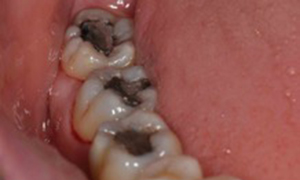
Once a tooth is decayed, it has to be immediately restored back to its normal contour by removing the caries and filling it with inert materials. These dental fillings take the place of the lost tooth structure in the oral cavity. They are used on either one surface or all surfaces of the tooth. Dental amalgam fillings are the oldest in the field of dentistry.
This filling consists powder of various metals mainly silver and liquid consisting of mercury. It is long lasting and can withstand the wear and tear of mastication very well. As it is silver in colour, it is mostly used in the back teeth where masticatory forces are the maximum. It also darkens with time. As this filling stays in place mechanically the cavity should have undercuts. Incase of extensive destruction of the tooth metal pins are placed in the tooth for better retention.
This filling can withstand heavy loading thus it is very useful in the back teeth. It is cheaper in comparison to gold and composite fillings.
Moisture contamination should not be present during restoring amalgam as the filling can swell and generate pressure on the tooth. After sometime mercury leakage can occur, this is harmful to general health. Patients can have allergy to mercury and in such patients this restoration is not used. It should be avoided in females during pregnancy. It darkens with time.
The filling hardens completely after 24 hours. Hence the patient is told not to apply heavy forces on the filled tooth.
D) Dental Inlays and Onlays:
When the extension of caries is present on more than one surface but not the whole tooth then chances of restorations like silver amalgam or composite to fracture are high. In such cases inlays or onlays can be preferred to full crowns. These fillings are fabricated in a dental lab and then are cemented on the tooth with the help of cements. They have more strength and are resistant to fracture.
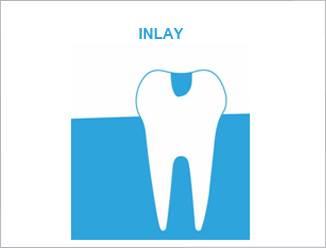
When the restoration is present within the confines of the tooth it is called an inlay. Here only the chewing surface is involved.
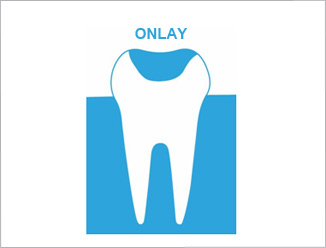
When the restoration covers more than one surface involving a cusp then it is called an onlay.
Once the extent of caries is found clinically and with the help of X-ray, our restorative dentists will meticulously remove the carious part of the tooth. After the preparation is over an impression of the prepared area is taken and sent to the lab for fabrication of the inlay/onlay. Till the restoration is ready a temporary filling is placed so that the tooth does not suffer further damage. Once the inlay/onlay is fabricated then the temporary restoration is removed and the final filling is stuck on the tooth with cement. After cementation it is checked whether it is not interfering in various activities like biting, chewing or at rest. If it is interfering then the restoration is trimmed a little and polishing is carried out.

Metal inlay/onlay
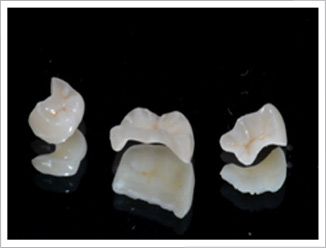
Ceramic inlay/onlay
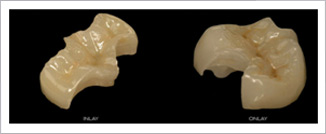
Zirconia inlay/onlay
Earlier gold alloys were used as it gives great strength to the tooth. It can be polished well and its adaptation to tooth surface is very good. But with the advancement of improved materials now-a-days tooth coloured materials with good strength like porcelain, ceramic or zirconia are used. These materials are just like our tooth colour and intricate details like grooves and ridges can be fabricated on them.
Advantages are that they do not discolour as resins do after a long time; they are conservative procedures so least amount of tooth is compromised; they do not shrink like composites. Their disadvantages are that they are costly as compared to other direct fillings as lab procedures are involved and also that repeated appointments are required.
After cementation of the restoration patient is called after 2-3 days for a check up to see whether there are any high points or sharp edges. The patient is informed that mild tooth sensitivity to hot/cold food would be present for sometime till the tooth adjusts to the restoration. Proper oral hygiene should be maintained and a recall is required every 6 months to check for any minor fractures or leakage.
E) Dental crowns:
Crowns are fondly known as caps by patients.
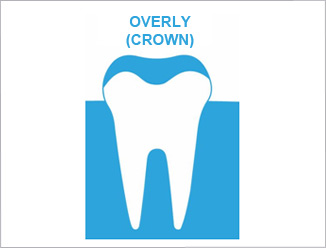
When the tooth is beyond repair or it is cracked due to trauma, extensive caries, only then a crown is placed on the tooth. Its purpose is to encompass the weakened tooth, give it strength and resume its function. It can be made of various materials like metal, porcelain fused to metal, full ceramic or zirconia.
Our skilled dental professionals would first check your tooth and then come to the conclusion whether a crown is needed or not as we first believe in conservative dentistry wherein the maximum amount of natural structures are tried to be preserved. Following conditions would mandate a crown fabrication such as a large decay present in the tooth, if the tooth is extensively broken due to trauma, if the tooth is weak due to cracks, discoloured tooth hampering the aesthetics of the patients smile, incase if the tooth is not in position in the jaw or it is of not proper shape. Certain procedures like root canal treatment or implant placement also need a crown post treatment so that it camouflages with the surrounding natural teeth to give a perfect radiating smile..
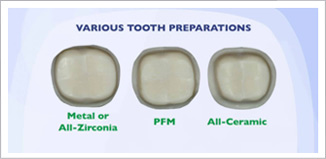
When a crown is deemed necessary the patient will be informed about it and the various materials are explained to the patient.
On the next appointment the procedure is started by giving a local anaesthesia to numb the tooth so that there is no sensitivity during crown preparation. The tooth is reduced all over by removing the outer layer according to the size of the crown to be placed on it. Thereafter a final impression of the prepared tooth is taken and a mould is prepared which is sent to the laboratory for the fabrication of the crown. Until then the temporary crown is placed on the tooth to prevent it from fracture and sensitivity. Proper oral hygiene procedures are explained to the patient for the care of the crown. The next appointment is scheduled after 3-4 days once the final crown is sent by the lab.
On the third appointment the temporary crown is removed and the permanent crown is placed on the tooth which is of the same colour of the surrounding teeth incase when tooth coloured materials are used. Final finishing is done and the patient is asked to check if there are any premature contacts of the other teeth due to the crown. Once the patient is satisfied oral hygiene instructions are again reinforced to the patient. The permanent crown is cemented to the tooth and the proud and confident patient is ready to face the world with his new found smile that was restored because of the crown fabricated by our skilled professionals.
Advantages are that it strengthens the tooth structure, can last upto 8-9 years if properly taken care of, excellent aesthetics similar to the natural tooth and most importantly it restores the tooth back to its function.
Its disadvantages can be that they are expensive as compared to tooth fillings, sound tooth structure has to be reduced to make space for the crown, if root canal treatment is not carried out; then the patient can feel sensitivity to hot and cold food, gum inflammation can arise leading to bone loss if the crown margins are not properly placed, ceramic can chip off if it is not fabricated properly. Secondary caries can also occur if the cement used to stick the crown disintegrates.
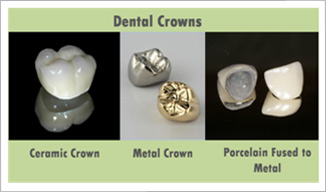
Earlier crowns were made of gold, followed by metal. But both of them were not tooth coloured so now their use is very limited. With advanced technology now crowns are available in tooth coloured materials like composite, porcelain fused to metal where ceramic coating is given to metal crown to hide its silver colour. This crown has excellent strength of metal and amazing colour matching due to ceramic. Other materials used are full ceramic or zirconia crowns which are mostly placed in front teeth as the given excellent colour matching to adjacent teeth. Thus, they give an illusion of a natural tooth.
Once the crown is in place, the dentist will give a series of instructions to follow which should to taken in account to increase the longitivity of the crown. Proper oral hygiene should be maintained like brushing twice along with flossing and using mouth rinses, avoid biting hard food. Incase if you have habit of clenching your teeth inform your dentist so that a night guard can be fabricated which has to be worn at night thus reducing the biting forces on the crown and ensuring its long survival. A visit to the dentist every 6 months is mandatory.
